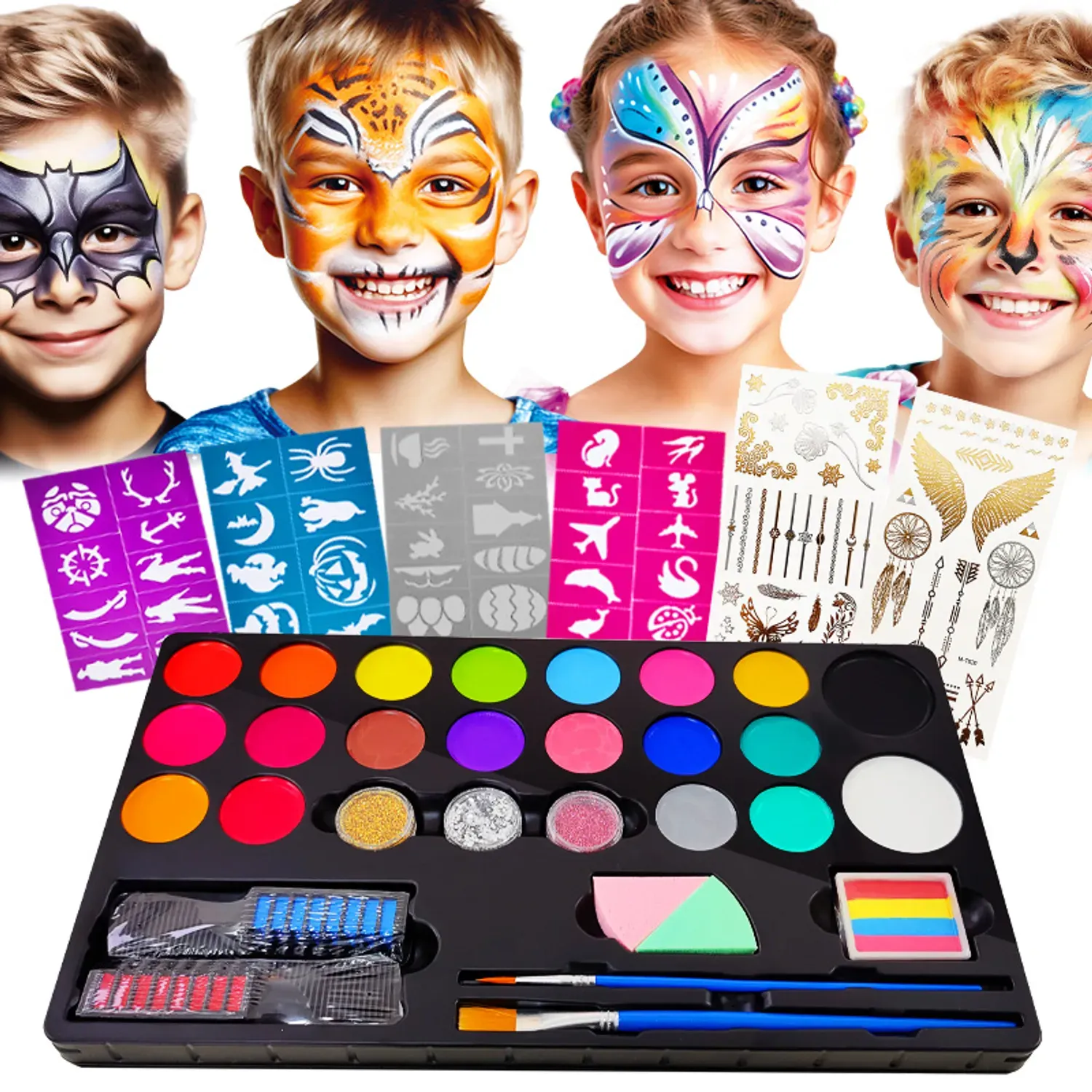betty@kaihong888.com

Get A Quote
How Are Face Paints Made?
But have you ever wondered, “How are face paints made?” This question takes us behind the scenes of an industry dedicated to creating safe, vivid, and versatile products for every occasion.
The History and Evolution of Face Paints
Before diving into the modern manufacturing process, it’s important to appreciate the rich history of face paints. Ancient civilizations used natural pigments for ceremonial and cultural purposes. Indigenous tribes across Africa, Australia, and the Americas relied on minerals, plants, and even insects to create their face paints. These natural elements were the precursors to today’s more sophisticated formulations. For instance, the ancient Egyptians used kohl to darken their eyes, while Native American tribes used ochre and clay for face painting during rituals.
The Modern Face Paints: Ingredients and Safety
In contemporary times, face paints are meticulously crafted to ensure safety and effectiveness. The primary ingredients in face paints include:
- Pigments: These provide the color. Modern pigments are usually synthetic to ensure consistency and vibrancy. However, they are rigorously tested for safety, particularly for use on sensitive skin. Natural pigments, such as iron oxides, are also used in some formulations to offer an alternative for those with sensitive skin.
- Binders: These hold the pigment particles together and help them adhere to the skin. Common binders include glycerin and natural gums. Binders ensure that the paint remains on the skin for a reasonable duration without cracking or smudging.
- Base: The base forms the bulk of the face paint. It can be water-based, oil-based, or cream-based, depending on the desired texture and ease of removal. Water-based paints are popular for their ease of use and clean removal, while oil-based paints are favored for their durability.
- Additives: These are included to enhance the paint’s performance. Additives like preservatives prevent microbial growth, while emollients keep the paint smooth and spreadable. Additional ingredients, such as fragrances and vitamins, can be included to improve the user experience and provide added benefits like skin hydration.
How Are Face Paints Made?
The process of making face paints involves several steps to ensure a high-quality product that is both safe and enjoyable to use.
Formulation
The first step in creating face paints is formulation. Cosmetic chemists develop recipes by combining pigments, binders, bases, and additives in precise proportions. This stage involves a lot of trial and error to achieve the perfect balance of color intensity, texture, and safety. Formulators also consider factors like the target demographic, skin types, and specific usage scenarios (e.g., professional performances vs. children’s parties).
Mixing
Once the formulation is perfected, the ingredients are mixed. This is done in large industrial mixers to ensure a consistent blend. The pigments are carefully dispersed in the base, which can be a delicate process. Uneven mixing can lead to streaky or patchy face paint. Advanced mixing techniques, such as homogenization, are often employed to achieve a smooth and uniform product.
Testing
Before face paints hit the market, they undergo rigorous testing. This includes stability tests to ensure the paint doesn’t separate or degrade over time. Dermatological testing is also crucial to confirm that the product is safe for use on skin. This step is vital to prevent allergic reactions and ensure the face paint meets all regulatory standards. Additionally, consumer testing is conducted to gather feedback on the product’s performance and comfort.
Packaging
After passing all tests, the face paint is ready for packaging. This involves filling containers like pots, tubes, or palettes, which are then sealed to maintain freshness. Packaging also plays a role in the user experience, as it must be functional and easy to use, especially for detailed work or quick applications. Environmentally friendly packaging options are increasingly popular, reflecting a growing awareness of sustainability.
Types of Face Paints
Face paints come in various forms, each suitable for different applications:
- Water-Based Paints: These are the most common and are easy to apply and remove. They’re ideal for children’s face painting as they are gentle on the skin and wash off with soap and water. They dry quickly and are less likely to cause irritation, making them a favorite for both amateur and professional use.
- Grease Paints: These offer more durability and are often used by professional performers. They require a setting powder to prevent smudging and a special remover to clean off. Grease paints are known for their vibrant colors and ability to stay intact under hot stage lights.
- Alcohol-Based Paints: These are used for special effects makeup due to their longevity and resistance to sweat. They are more challenging to remove but provide the best durability for long performances or events. Alcohol-based paints are commonly used in film and TV for their realistic finish and staying power.
- Cream-Based Paints: These are versatile and blend well, making them popular for detailed work. They are commonly used in theatrical makeup. Cream-based paints are favored for their smooth application and ability to create gradients and shading effects.
DIY Face Paints: A Safe Alternative?
For those who prefer a homemade touch, DIY face paints are an option. By using ingredients like cornstarch, lotion, and food coloring, you can create your own face paints at home. However, it’s essential to ensure all ingredients are safe for skin application, especially for children. Homemade face paints can be a fun and creative project, but they lack the rigorous testing and stability of commercial products. Always patch test any DIY paint on a small area of skin before full application to avoid potential reactions.
Conclusion
Face paints have evolved from ancient natural pigments to sophisticated modern formulations, offering endless possibilities for artistic expression. Understanding how face paints are made reveals the careful consideration and scientific expertise involved in creating these colorful products. Whether used for festive fun, theatrical performances, or cultural traditions, face paints continue to be a beloved tool for transforming faces into works of art.
If you're inspired to dive into the world of face painting, look no further than KHY's comprehensive DIY body painting supplies. KHY offers a wide range of vibrant, skin-safe paints designed for both hobbyists and professionals. Whether you're creating detailed designs for a theater production, participating in a festive celebration, or simply enjoying a fun activity with friends and family, KHY's products ensure you have the best tools at your disposal.
With KHY’s extensive palette, you can explore your creativity with confidence, knowing that each product is crafted to the highest standards of safety and quality. Unleash your creativity with KHY and turn every face into a masterpiece.

